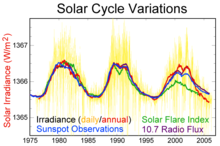Solar maximum: Difference between revisions
No edit summary |
No edit summary |
||
| Line 3: | Line 3: | ||
'''Solar maximum''' or '''solar max''' is the period of greatest solar activity in the [[solar cycle]] of the [[sun]]. During solar maximum, [[sunspot]]s appear.<ref>http://earthobservatory.nasa.gov/IOTD/view.php?id=37575</ref> |
'''Solar maximum''' or '''solar max''' is the period of greatest solar activity in the [[solar cycle]] of the [[sun]]. During solar maximum, [[sunspot]]s appear.<ref>http://earthobservatory.nasa.gov/IOTD/view.php?id=37575</ref> |
||
A solar maximum is the period when the sun's magnetic field lines are the most distorted due to the magnetic field on the solar equator rotating at a slightly faster pace than at the solar poles. The [[solar cycle]] takes an average of about 11 years to go from one solar maximum to the next with an observed variation in duration of 9 to |
A solar maximum is the period when the sun's magnetic field lines are the most distorted due to the magnetic field on the solar equator rotating at a slightly faster pace than at the solar poles. The [[solar cycle]] takes an average of about 11 years to go from one solar maximum to the next with an observed variation in duration of 9 to 14 years for any given solar cycle. |
||
For more detailed explanation of solar cycles, see [[Solar variation]]. |
For more detailed explanation of solar cycles, see [[Solar variation]]. |
||
Revision as of 00:29, 1 January 2011

Solar maximum or solar max is the period of greatest solar activity in the solar cycle of the sun. During solar maximum, sunspots appear.[1]
A solar maximum is the period when the sun's magnetic field lines are the most distorted due to the magnetic field on the solar equator rotating at a slightly faster pace than at the solar poles. The solar cycle takes an average of about 11 years to go from one solar maximum to the next with an observed variation in duration of 9 to 14 years for any given solar cycle.
For more detailed explanation of solar cycles, see Solar variation.
Historic maxima

The last solar maximum was in 2000. The next solar maximum is currently predicted to occur in May 2013 and to be one of the weakest cycles since 1928.[2][3]
The unreliability of solar maxima is demonstrated in that NASA had previously predicted the solar maximum for 2010/2011 and possibly to occur as late as 2012. Previously, on March 10, 2006, NASA researchers had announced that the next solar maximum would be the strongest since the historic maximum in 1958 in which the northern lights could be seen as far south as Rome, approximately 42° north of the equator.[4]
Film
There is an IMAX documentary about solar maxima called Solarmax.
See also
- Solar cycle 24
- Solar minimum
- List of solar cycles - table of solar cycles
- Solar Maximum Mission
References
- ^ http://earthobservatory.nasa.gov/IOTD/view.php?id=37575
- ^ "New Solar Cycle Prediction", Science@NASA, 09 May 2006, Accessed 26 Mar. 2010
- ^ "Solar Cycle Process and Prediction", NOAA/Space Weather Center, 9 May 2009, Accessed 22 Mar. 2010
- ^ "Solar Storm Warning", Science@NASA, 10 March 2006, Accessed 26 Mar. 2010
